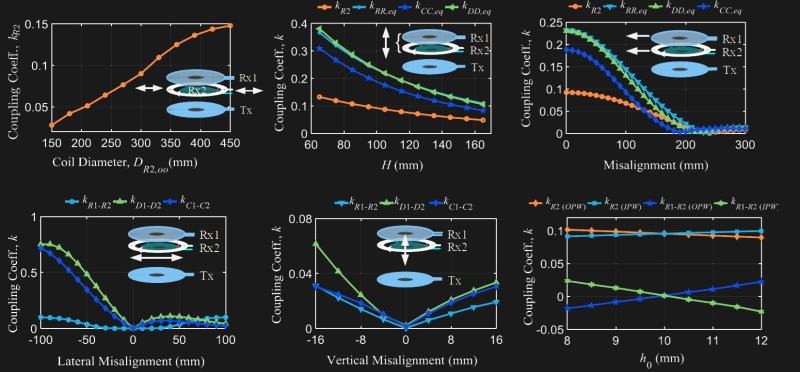[Nikola Tesla] believed he could wirelessly supply power to the world, but his calculations were off. We can, in fact, supply power wirelessly and we are getting better but far from the dreams of the historical inventor. The mainstream version is the Qi chargers which are what phones use to charge when you lay them on a base. Magnetic coupling is what allows the power to move through the air. The transmitter and receiver are two halves of an air-core transformer, so the distance between the coils exponentially reduces efficiency and don’t even think of putting two phones on a single base. Well, you could but it would not do any good. [Chris Mi] at San Diego State University is working with colleagues to introduce receivers which feature a pass-through architecture so a whole stack of devices can be powered from a single base.
Efficiency across ten loads is recorded at 83.9% which is phenomenal considering the distance between each load is 6 cm. Traditional air-gap transformers are not designed for 6 cm, much less 60 cm. The trick is to include another transmitter coil alongside the receiving coil. By doing this, the coils are never more than 6 cm apart, even when the farthest unit is a long ways from the first supply. Another advantage to this configuration is that tuned groups continue to work even when a load changes in the system. For this reason, putting ten chargeables on a single system is a big deal because they don’t need to be retuned when one finishes charging.
We would love to see more of this convenient charging and hope that it catches on.
Via IEEE Spectrum.
















I once tried to put two devices on a single Qi charging base. It caught fire. The smell was horrible.
“Nikola Tesla believed he could wirelessly supply power to the world, but his calculations were off.”
now that’s a statement…
So when reading this I was expecting something very spectacular… yet it failed a few lines later when it became clear that it was all about wirelessly charging of phones. Perhaps the most complicated way to save a power plug.
Just another step in lowering the overall efficiency of the charging cycle. If this catches on then perhaps billions of phones all around the world will be wasting precious resources, all together consuming the power of a small city and why? So we can save 2 seconds because we don’t have to put a peg into a hole.
Well, from what I keep reading young people these days are less and less prone to put their pegs in their holes so maybe they need this. Just look at Japan. They seem to be the trend setters.
I like wireless charging for a few minor reasons.
My cheap charger is lower power, meaning slower charfing, which is beter for my battery.
Also less wear and tear on the connector. Ive thrown away quite a few usb cables because the only way they kept working is to ‘wiggle’ them
Finally i can keep a dust plug in the socket, so pess gunk and liquid going in!
So no, its not that bad of an idea, now granted if we improve efficiency it be better for all of us…
Woosh!
I had to admit I felt the same way when I was first introduced to wireless chargers but after setting one up for my wife to play with have found it rather useful for her. In her case it was particularly useful when she was feeding the baby as it was a lot easier to use one handed than any other plug based system we had.
Granted this is an edge use case but the cost in efficiency was made up for in the gains in usability.
Jan, that’s what prople said about wireless phones. Why bother when u have a phone at home, in ur car, at work?
Hmmm, interesting. I can use my phone when it’s charging on a cable — especially a 3m cable. Can we say the same for a Qi charger? I mean, the range on those is centimeters.
(I know that’s not what you meant, but at the same time, funny that the wireless technology is actually the LESS mobile one!)
Conference calls
I’m waiting for Apple to make a “courageous” move by removing the ability to charge via cable all together.
Connectors do take up a lot of space. This could be the way things go.
But like AirPods, there is no way to charge your phone on planes…
There is just too much going on in that port for now anyway: data, power, recovery mode, etc. I think we are safe!